Clauses: Definition, Meaning, and How to Use Them
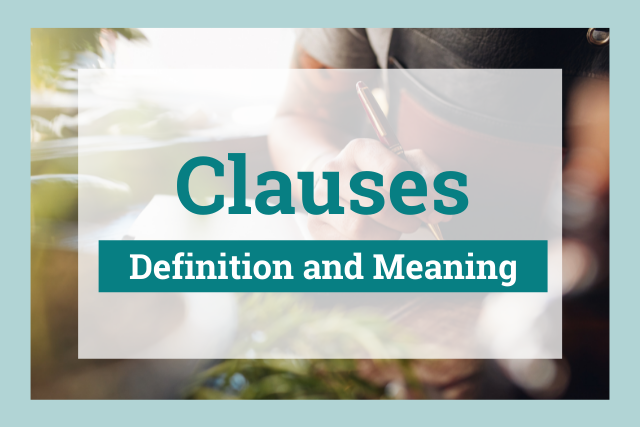
A clause is a group of words that contains a subject and a predicate.
The subject is who or what the sentence is about and will always be a noun or pronoun.
The predicate is the part of a sentence that contains the verb and tells the reader something about the subject.
Read on to learn more about the different clauses, some examples, and how you can identify and use them.
Clauses: Definition
A clause is a part of a sentence that includes at least one subject and one verb.

There are two types of clauses: independent and dependent ones. Independent clauses can stand alone as a sentence and dependent clauses cannot stand alone because they do not contain a full thought.
Clauses: Meaning
Clauses make up sentences. They are the building blocks of language and are essential for all verbal communication.
Clauses can work independently to convey simple information, or they can work together to convey more complex thoughts and ideas.
Understanding clauses is an essential step towards creating clear, effective, and understandable content.
What Are Independent Clauses?
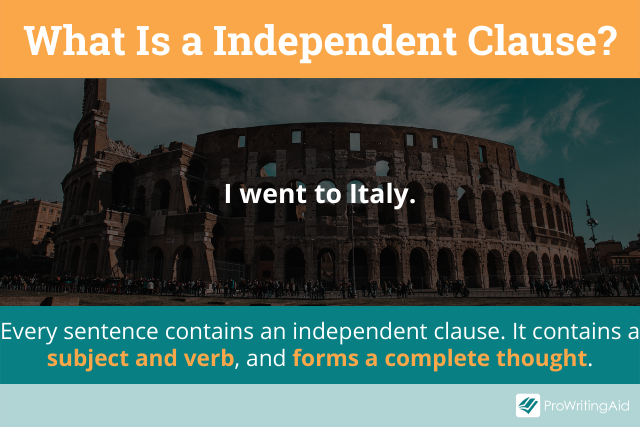
Independent clauses (or main clauses) are the most basic types of sentences. Every sentence contains an independent clause.
Each independent clause contains three elements:
- The subject
- The predicate
- A complete thought
Independent Clause Examples
Independent clauses can also be combined with other independent or dependent clauses to form more complicated sentences.
- A sentence with two independent clauses is a compound sentence.
- A sentence with one independent clause and one or more dependent clauses is a complex sentence.
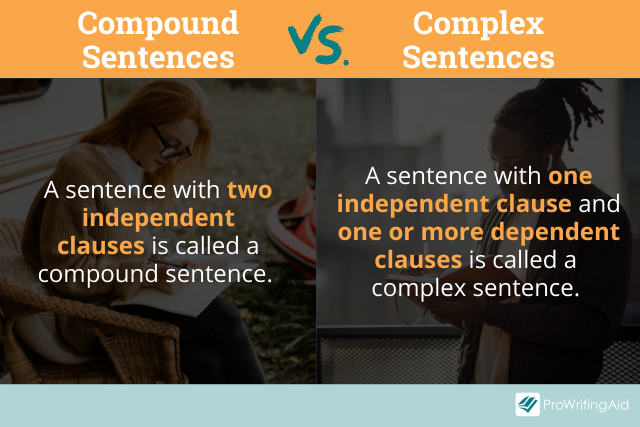
Below are some examples of independent clauses and how they could be extended to form compound or complex sentences.
- The bells are ringing.
“The bells” is the subject, “are” is the verb, and “ringing” is the adjective that forms the complete thought.
- The fountain is beautiful.
“The fountain” is the subject, “is” is the verb, and “beautiful” is the adjective that completes the thought.
- My dog sleeps by the fire.
Make this sentence into a compound sentence by adding a coordinating conjunction (and) and the second independent clause “my cat sleeps there too.”
- She won her 200m race.
In this sentence, “she” is the subject, “won” is the verb, and “her 200m race” completes the thought. The completion of a thought can be a single word or a whole phrase.
- Emma ran to the bus.
This independent clause could be made into a complex sentence by adding the dependent clause “she was late.” These would then need to be connected by a subordinating conjunction such as “because.”
What Are Dependent Clauses?
A dependent clause (or subordinate clause) contains a subject and a verb but does not form a complete sentence. Not every sentence contains a dependent clause because they are not always necessary to create meaning.
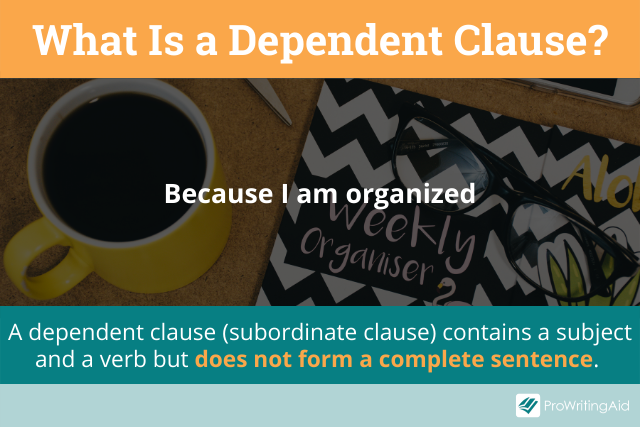
There are three subtypes of dependent clauses: adjective clauses, noun clauses, and the less common adverbial clause. There are then two further subtypes of adjective clauses, which are restrictive and non-restrictive clauses.
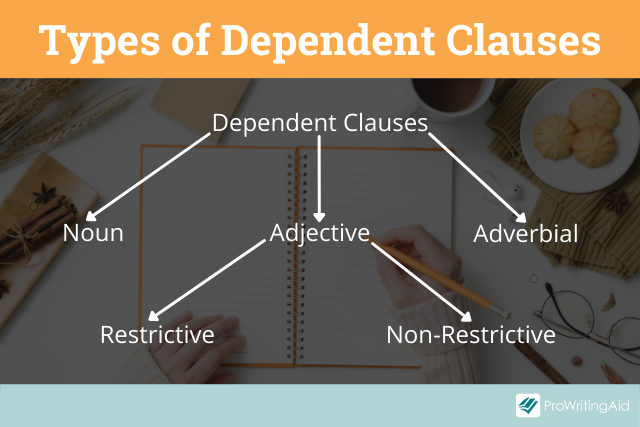
All dependent clauses are either noun clauses, adjective clauses, or adverbial clauses.
What Are Adjective Clauses?
An adjective clause, or relative clause, is a type of dependent clause that provides more information about a noun.

Like dependent clauses, adjective clauses also contain a subject and a verb and cannot stand alone as a complete sentence.
There are two types of adjective clauses: essential and non-essential.
If the clause is non-essential, offset the phrase with commas. If the clause is essential, then the sentence will not make sense if it’s removed and, as a result, should not be offset by commas.
Adjective clauses usually begin with relative pronouns or relative adverbs.
Relative pronouns are the subject or object of the relative clause (adjective clause). Examples include who, that, whose, which, and whom.
Relative adverbs can be used to start an adjective clause. Examples include when, where, and why.
Adjective Clause Examples
Below are some bolded examples of essential and non-essential adjective clauses (relative clauses) in sentences.
- Jackfruit, which is grown in Bangladesh, is the largest fruit grown on a tree.
This adjective clause is non-essential because it provides some interesting information in this sentence but can be taken out without changing the meaning.
- Never trust a chef who won’t eat their own cooking.
This adjective clause is essential because taking it out would leave us with “never trust a chef,” which is an unjustified statement. The adjective clause is necessary to clarify the statement.
- I know someone who has their own horse.
Without the adjective clause this sentence would read “I know someone” which may be true but doesn’t provide any useful information.
- The musical Hamilton is about George Washington, who was the first president of the United States.
Adjective clauses can appear in the middle or at the end of sentences like in this example.
- I love the schnauzer who lives next door.
Although the speaker may know exactly what schnauzer they are talking about, the adjective clause is essential for specifying to a reader which dog they mean.
What Are Restrictive and Non-Restrictive Clauses?
Restrictive and non-restrictive clauses are adjective clauses that are types of dependent clauses. This means that they require an independent clause to make sense.
- Restrictive clauses, also known as essential clauses, narrow down the preceding subject and tell you which specific one is being talked about.
- Non-restrictive clauses, also known as non-essential clauses, provide information about a preceding subject without limiting or restricting it.

Restrictive and Non-Restrictive Clause Examples
To work out if an adjective clause is restrictive or non-restrictive, ask yourself if the meaning would change if it was taken out.
If it does change, it is restrictive because it is essential for the meaning. If it doesn’t change, it is non-restrictive because it is not essential for the meaning.
Here are a few examples to help show this concept.
- My two daughters, who are seven and eight, are both ballet dancers.
This is a non-restrictive clause because knowing the ages of the girls does not help to identify them when the speaker has specified that they only have two daughters.
- Malbork Castle, which was built in the 13th century, is the biggest castle in the world.
This is also a non-restrictive clause because the castle has been specifically identified by its name and could not be confused for any other building.
- The donuts that you can only buy in Universal Orlando are the best in the world.
Without this restrictive clause we would be left with a paradox because it is impossible for a donut to be classed as “the best” if you are referring to every donut.
What Are Noun Clauses?
The second type of dependent clause is a noun clause. They are so common that many people consider them to be one of the four main types of clauses along with independent, dependent, and adjective.
A noun clause can take the place of any noun in a sentence.
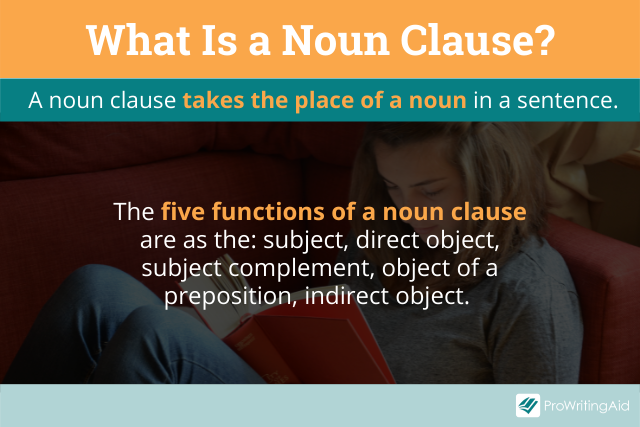
There are five functions of a noun clause: as a subject, direct object, indirect object, object of the preposition, or subject complement.
- A subject performs the action and is the thing that is being described.
- A direct object receives the action of the verb.
- An indirect object is the thing that receives the direct object.
- The object of a preposition is a noun that works alongside a preposition to form a prepositional phrase. It can usually be found just after the preposition.
- A subject complement follows a linking verb and modifies or identifies the subject.
Noun Clause Examples
- A person who is trusted by dogs should be trusted by people.
The noun clause here is acting as the subject of the sentence.
- She must pick which type of coffee she wants.
The noun clause is acting as the direct object because it receives the action of the verb “pick.”
- Layla gave that her brother want some of her chocolate some thought.
Using a noun clause as an indirect object is rare because it forms clunky, hard-to-read sentences, like the one above.
- Bertha always agrees with whatever Jojo says.
This noun clause is the object of a preposition. In this sentence, “with” is the preposition.
- Her favorite part of the day was that they got given chocolate ice-cream.
The linking verb “that” means that this noun clause is a subject complement that modifies the subject “her favorite part of the day.”
What Are Adverbial Clauses?
An adverbial clause is a group of words that forms a dependent clause and that functions as an adverb. Like dependent clauses they always contain a subject and a verb.
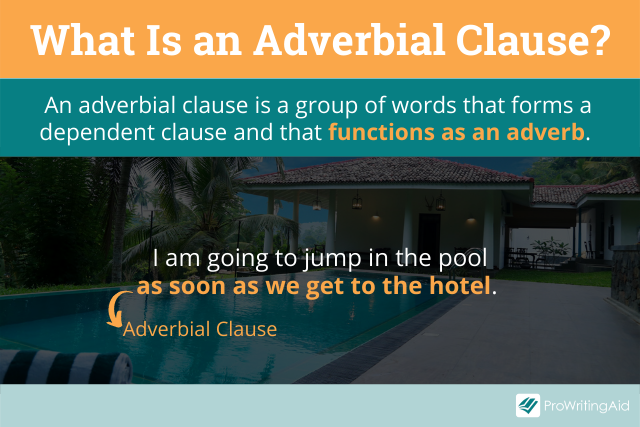
Adverbial clauses typically explain time, frequency, and manner by answering, who, what, how, when, and why.
Adverbial Clause Examples
Adverbial clauses add nuance to sentences but they are never essential for the meaning. If they are taken out you would still be left with a full sentence that makes sense.
Below are some examples of adverbial clauses with an explanation as to whether they answer the question: who, what, when, where, or why.
- Wherever you go I will follow you.
The adverbial clause describes where the speaker is going and it precedes the independent clause.
- I am going to jump in the pool as soon as we get to the hotel.
This adverbial gives more information about when the action of the independent clause is going to take place.
- I will shop until I drop.
The phrase until I drop provides a time frame (when) for the actions of the independent clause.
- She was promoted because she worked hard.
This clause is explaining why she was promoted. It is the cause of the independent clause.
- If you eat your carrots you can have dessert.
This clause explains how by providing a condition for the following independent clause.
How to Identify Clauses in a Sentence
Now you know what clauses are, you’ll understand why it is important to know how to identify them in a sentence. Every clause contains a verb and, because of this, looking for the verb is the easiest way to identify a clause.
This article covers a lot of ground. Are there any aspects of clauses that you would like to learn more about? Let us know in the comments and you just might see a new explainer article coming your way.